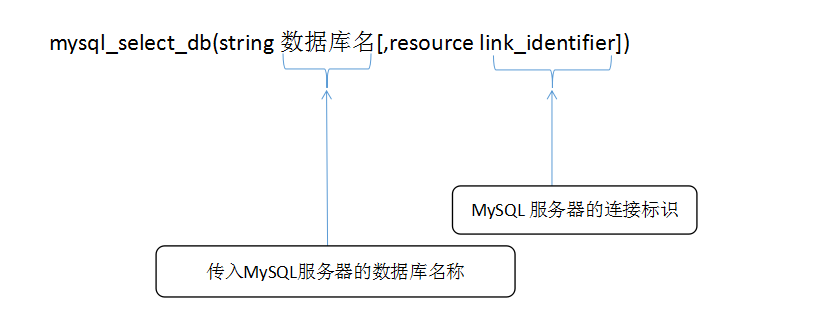Recommended articles about mysql_select_db()
How to operate MySQL database with PHP - how to select a database file. In our daily PHP development work, when we want to obtain data from the database, after PHP connects to the database, the next step is to select the database file. A function is used, the mysql_select_db() function selects the database! Before choosing a database, the first thing we do is connect PHP to the database. We have detailed how to establish a connection in the previous article "Using the mysql_connect() function to connect to the database (Method 1 of PHP operating MySQL database)". I won’t introduce much here. Today we will mainly talk about the mysql_select_db() function! The syntax format of the mysql_select_db() function is as follows: mysql_select_db(string database name[,resource link_identifier]) or: mysql_query("use database name"[,resource&
1. About selecting database files Detailed introduction

Introduction: How to operate MySQL database with PHP - How to select database files in our daily PHP During development work, when we want to obtain data from the database, after connecting to the database in PHP, the next step is to select the database file, and we need to use a function, the mysql_select_db() function to select the database! The first thing to do is to connect PHP to the database. We discussed this in the previous article "Using the mysql_connect() function to connect to the database (How PHP operates the MySQL database...
##2. Use the mysql_select_db() function to select the database file (method 2 of PHP operating MySQL database)

Introduction : In our daily PHP development work, when we want to obtain data from the database, after PHP connects to the database, the next step is to select the database file, and we need to use a function, the mysql_select_db() function to select the database!
3. The difference between mysql_db_query and mysql_query
Introduction: I won’t talk about the difference. Just look at the above examples. Got it, the main difference is that there is one more mysql_select_db. Regarding performance, the use of this function is not recommended since PHP 4.0.6. Do not use this function. Use mysql_select_db() and mysql_query() instead##.
#4.CAPI function description (S-W)
Introduction: 25.2.3.59. mysql_select_db() int mysql_select_db(MYSQL *mysql, const char *db ) Description Makes the database specified by db the default database (the current database) on the connection specified by mysql. In subsequent queries, this database will be the default database referenced by tables that do not contain an explicit database separator.5.
PHP self-study tutorial for MySQL database
Introduction: General steps for PHP to access MySQL database: 1. Connect to the MySQL database: Use the mysql_connect() function to establish a connection to the MySQL server. 2. Select the MySQL database: Use the mysql_select_db() function to select the database on the MySQL database server. 3. Execute the SQL statement: use the mysql_query() function in the selected databaseThe above is the detailed content of Recommended articles about mysql_select_db(). For more information, please follow other related articles on the PHP Chinese website!

Hot AI Tools

Undresser.AI Undress
AI-powered app for creating realistic nude photos

AI Clothes Remover
Online AI tool for removing clothes from photos.

Undress AI Tool
Undress images for free

Clothoff.io
AI clothes remover

Video Face Swap
Swap faces in any video effortlessly with our completely free AI face swap tool!

Hot Article

Hot Tools

Notepad++7.3.1
Easy-to-use and free code editor

SublimeText3 Chinese version
Chinese version, very easy to use

Zend Studio 13.0.1
Powerful PHP integrated development environment

Dreamweaver CS6
Visual web development tools

SublimeText3 Mac version
God-level code editing software (SublimeText3)

Hot Topics
 MySQL: An Introduction to the World's Most Popular Database
Apr 12, 2025 am 12:18 AM
MySQL: An Introduction to the World's Most Popular Database
Apr 12, 2025 am 12:18 AM
MySQL is an open source relational database management system, mainly used to store and retrieve data quickly and reliably. Its working principle includes client requests, query resolution, execution of queries and return results. Examples of usage include creating tables, inserting and querying data, and advanced features such as JOIN operations. Common errors involve SQL syntax, data types, and permissions, and optimization suggestions include the use of indexes, optimized queries, and partitioning of tables.
 How to open phpmyadmin
Apr 10, 2025 pm 10:51 PM
How to open phpmyadmin
Apr 10, 2025 pm 10:51 PM
You can open phpMyAdmin through the following steps: 1. Log in to the website control panel; 2. Find and click the phpMyAdmin icon; 3. Enter MySQL credentials; 4. Click "Login".
 Why Use MySQL? Benefits and Advantages
Apr 12, 2025 am 12:17 AM
Why Use MySQL? Benefits and Advantages
Apr 12, 2025 am 12:17 AM
MySQL is chosen for its performance, reliability, ease of use, and community support. 1.MySQL provides efficient data storage and retrieval functions, supporting multiple data types and advanced query operations. 2. Adopt client-server architecture and multiple storage engines to support transaction and query optimization. 3. Easy to use, supports a variety of operating systems and programming languages. 4. Have strong community support and provide rich resources and solutions.
 MySQL's Place: Databases and Programming
Apr 13, 2025 am 12:18 AM
MySQL's Place: Databases and Programming
Apr 13, 2025 am 12:18 AM
MySQL's position in databases and programming is very important. It is an open source relational database management system that is widely used in various application scenarios. 1) MySQL provides efficient data storage, organization and retrieval functions, supporting Web, mobile and enterprise-level systems. 2) It uses a client-server architecture, supports multiple storage engines and index optimization. 3) Basic usages include creating tables and inserting data, and advanced usages involve multi-table JOINs and complex queries. 4) Frequently asked questions such as SQL syntax errors and performance issues can be debugged through the EXPLAIN command and slow query log. 5) Performance optimization methods include rational use of indexes, optimized query and use of caches. Best practices include using transactions and PreparedStatemen
 How to connect to the database of apache
Apr 13, 2025 pm 01:03 PM
How to connect to the database of apache
Apr 13, 2025 pm 01:03 PM
Apache connects to a database requires the following steps: Install the database driver. Configure the web.xml file to create a connection pool. Create a JDBC data source and specify the connection settings. Use the JDBC API to access the database from Java code, including getting connections, creating statements, binding parameters, executing queries or updates, and processing results.
 How to start mysql by docker
Apr 15, 2025 pm 12:09 PM
How to start mysql by docker
Apr 15, 2025 pm 12:09 PM
The process of starting MySQL in Docker consists of the following steps: Pull the MySQL image to create and start the container, set the root user password, and map the port verification connection Create the database and the user grants all permissions to the database
 MySQL's Role: Databases in Web Applications
Apr 17, 2025 am 12:23 AM
MySQL's Role: Databases in Web Applications
Apr 17, 2025 am 12:23 AM
The main role of MySQL in web applications is to store and manage data. 1.MySQL efficiently processes user information, product catalogs, transaction records and other data. 2. Through SQL query, developers can extract information from the database to generate dynamic content. 3.MySQL works based on the client-server model to ensure acceptable query speed.
 How to install mysql in centos7
Apr 14, 2025 pm 08:30 PM
How to install mysql in centos7
Apr 14, 2025 pm 08:30 PM
The key to installing MySQL elegantly is to add the official MySQL repository. The specific steps are as follows: Download the MySQL official GPG key to prevent phishing attacks. Add MySQL repository file: rpm -Uvh https://dev.mysql.com/get/mysql80-community-release-el7-3.noarch.rpm Update yum repository cache: yum update installation MySQL: yum install mysql-server startup MySQL service: systemctl start mysqld set up booting






